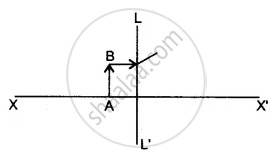Advertisements
Advertisements
Question
Surabhi from std. X uses spectacle. The power of the lenses in her spectacle is 0.5 D.
Answer the following questions from the given information:
- Identify the type of lenses used in her spectacle.
- Identify the defect of vision Surabhi is suffering from.
- Find the focal length of the lenses used in her spectacle.
Solution
1) The power is positive hence the convex lens
2) Hypermetropia
3) `"P" =1/"F"`
`"f" = 1/"P" = 1/0.5 = 2 "m"`
= 200 cm
APPEARS IN
RELATED QUESTIONS
What is meant by a power of a lens? Define its SI unit.
Define the power of a lens.
How unit of power related to focal length of a lens?
Find the power of a concave lens of focal length 2m.
A student uses a lens of focal length 40 cm and another of –20 cm. Write the nature and power of each lens
Consider two statements A and B given below:
A: real image is always inverted
B: virtual image is always erect
Out of these two statements:
Which one of the following materials cannot be used to make a lens?
Name the physical quantity whose unit is dioptre.
The focal length of a lens is +150 mm. What kind of lens is it and what is its power?
Fill in the following blank with suitable words :
The reciprocal of the focal length in metres gives you the _________ of the lens, which is measured in ___________.
An object of height 4.25 mm is placed at a distance of 10 cm from a convex lens of power +5D. Find (i) the focal length of the lens, and (ii) the size of the image.
A convex lens of power 5 D and a concave lens of power 7.5 D are placed in contact with each other. What is the :
(a) power of this combination of lenses?
(b) focal length of this combination of lenses?
A convex lens of focal length 25 cm and a concave lens of focal length 10 cm are placed in close contact with one another.
(a) What is the power of this combination?
(b) What is the focal length of this combination?
(c) Is this combination converging or diverging?
Two lenses A and B have focal lengths of +20 cm and, −10 cm, respectively.
(a) What is the nature of lens A and lens B?
(b) What is the power of lens A and lens B?
(c) What is the power of combination if lenses A and B are held close together?
What is the unit of power of a lens? Define the unit of power of a lens.
Define the term focal length of a lens.
How is the sign (+ or -) of power of a lens related to its divergent or convergent action?
The power of a lens is + 1.0 D is :
Express the power (with sign) of a concave lens of focal length 20 cm.
A thin converging lens is formed with one surface convex and the other plane. Does the position of image depend on whether the convex surface or the plane surface faces the object?
A pin of length 2.00 cm is placed perpendicular to the principal axis of a converging lens. An inverted image of size 1.00 cm is formed at a distance of 40.0 cm from the pin. Find the focal length of the lens and its distance from the pin.
Consider the situation described in the previous problem. Where should a point source be placed on the principal axis so that the two images form at the same place?
A diverging lens of focal length 20 cm and a converging lens of focal length 30 cm are placed 15 cm apart with their principal axes coinciding. Where should an object be placed on the principal axis so that its image is formed at infinity?
How is accommodation produced?
A lens forms an upright and diminished image of an object, irrespective of its position. What kind of lens is this? Draw an outline ray diagram to show the formation of the image. State the position and one more characteristic of the image.
Complete the diagram to show the formation of the image of the object AB.

(i) Name the Lens LL’.
(ii) Where is the image of the object AB formed?
(iii) State three characteristics of the image.
If there is a convex lens of focal length 75 cm and a concave lens of focal length 40 cm, then calculate their combined power and combined focal length.
Focal length : metre : : power of lens : _______
The power of the magnifying glass depends on the distance of the magnifying glass from object.

The above lens has a focal length of 10 cm. The object of height 2 mm is placed at a distance of 5 cm from the pole. Find the height of the image.
A convex lens with radii of curvature R1 = R2 is immersed in water. Assuming that the refractive indices of glass and water are 3/2 and 4/3 respectively, its focal length f1 in comparison to that in air, f, is ______.
When monochromatic red light is used instead of blue light in a convex lens, its focal length will ______.
The focal length of a double convex lens is equal to the radius of curvature of either surface. What is the refractive index of its material?
